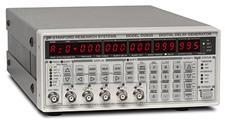Stanford DG645 Digital Delay/Pulse Generator

Stanford DG645 Digital Delay/Pulse Generator
Lower jitter, higher accuracy, faster trigger rates

The DG645 is a versatile digital delay/pulse generator that provides precisely defined pulses at repetition rates up to 10MHz. The instrument offers several improvements over older designs - lower jitter, higher accuracy, faster trigger rates and more outputs. The DG645 also has Ethernet, GPIB and RS232 interfaces for computer or network control of the instrument.
Features:
- 4 pulse outputs
- 8 delay outputs (opt)
- <25ps rms jitter
- Trigger rates to 10MHz
- Precision rate generator
- Fast transition times
- Ovenised crystal or rubidium timebase (opt)
- Ethernet, GPIB and RS232 interfaces
All digital delay generators measure time intervals by counting cycles of a fast clock (typically 100MHz). Most digital delay generators also have short programmable analog delays to achieve time intervals with finer resolution than the clock period. Unfortunately, one clock cycle indeterminacy (typically 10ns) can occur if the trigger is not in phase with the clock. The DG645 eliminates timing indeterminacy by measuring the timing of triggers with respect to the internal clock and compensating the analog delays. This approach reduces the jitter by about 100x and allows the internal rate generator to operate at any rate - not just a sub-multiple of the clock frequency.
The DG645 has many trigger modes. An internal rate generator, with less than 100ps period jitter, may be set from 100μHz to 10MHz with 1μHz resolution. An external trigger input, with adjustable threshold and slope, can trigger a timing cycle, a burst of cylces, or a single shot. A single shot can be triggered with a key press. A line trigger operates synchronously with the AC mains. A rear-panel trigger inhibit input can disable the trigger or any of the pulse outputs during a timing cycle.
For further information please contact us or download the datasheet.

